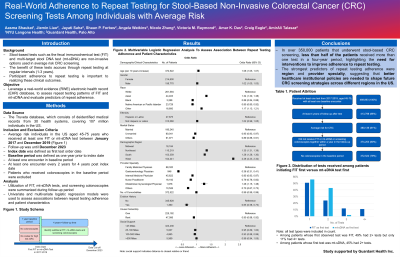Tuesday Poster Session
Category: Colon
P3672 - Real-World Adherence to Repeat Testing for Stool-Based Non-Invasive Colorectal Cancer Screening Tests Among Individuals With Average Risk
Tuesday, October 29, 2024
10:30 AM - 4:00 PM ET
Location: Exhibit Hall E

Has Audio

Aasma Shaukat, MD, MPH, FACG
Robert M. and Mary H. Glickman Professor of Medicine; Professor of Population Health; Director, GI Outcomes Research
NYU Langone Health
New York, NY
Presenting Author(s)
Award: Presidential Poster Award
Aasma Shaukat, MD, MPH1, Jiemin Liao, MA2, Jayati Saha, MS, PhD, MPH2, Shaun P. Forbes, PhD2, Angela Watkins, MBA, MPH3, Nicole J.. Zhang, MPH2, Victoria M.. Raymond, MS4, Amarendra Das, MD, PhD2, Craig Eagle, MD2, AmirAli Talasaz, PhD2
1NYU Langone Health, New York, NY; 2Guardant Health, Palo Alto, CA; 3Guardant Health, Redwood City, CA; 4Guardant Health, San Diego, CA
Introduction: Stool-based tests such as the fecal immunochemical test (FIT) and multi-target stool DNA test (mt-sDNA) are non-invasive options used in average risk CRC screening. The benefit of these tests accrues through repeat testing at regular intervals (1-3 years) and the participant adherence to repeat testing is important to realizing these clinical outcomes. Therefore, we sought to assess repeat testing patterns of FIT and mt-sDNA and to evaluate predictors of repeat adherence.
Methods: Patients were identified from the Truveta database, which consists of deidentified medical records from 30 health systems, covering 107 million individuals in the US. Patients aged 45-75 years who received at least one FIT or mt-sDNA test between 1/2017 and 12/2019 were included, with study end date of 12/2023. Index date was defined as the first test order date, with a baseline period of one year prior to index and 4 years of follow-up post index. Patients who had colonoscopies during baseline were excluded. Screening colonoscopies were included as a testing modality if they occurred during the follow-up period. Univariate and multivariable logistic regression models were used to assess associations between repeat testing adherence and patient characteristics.
Results: 372,522 eligible patients were identified. Most patients (52%) only received one FIT or mt-sDNA test over their four-year follow-up time. Among patients whose first observed test was FIT, 49% had 2+ tests, but only 11% had 4+ tests. Among patients whose first test was mt-sDNA, 45% had 2+ tests. Factors associated with repeat testing adherence (defined as 2+ tests during the entire study period), were male sex, married status, and non-Hispanic ethnicity. Compared to Whites, adherence was higher in Asians, while Black and Native American individuals were less likely to adhere to repeat testing. As compared to those age 50-64, repeat testing adherence was higher in those 65+ and lower in those less than 50 (Table 1).
Discussion: Our results found that less than half of patients who underwent stool-based CRC screening received more than one test in a four-year period, highlighting the need for interventions to improve adherence to repeat testing adherence, especially in women, Black and Native American individuals, and unmarried individuals. The strongest predictors of repeat testing adherence were region and provider specialty, suggesting that better healthcare institutional policies are needed to shape future CRC screening strategies.
Note: The table for this abstract can be viewed in the ePoster Gallery section of the ACG 2024 ePoster Site or in The American Journal of Gastroenterology's abstract supplement issue, both of which will be available starting October 27, 2024.
Disclosures:
Aasma Shaukat, MD, MPH1, Jiemin Liao, MA2, Jayati Saha, MS, PhD, MPH2, Shaun P. Forbes, PhD2, Angela Watkins, MBA, MPH3, Nicole J.. Zhang, MPH2, Victoria M.. Raymond, MS4, Amarendra Das, MD, PhD2, Craig Eagle, MD2, AmirAli Talasaz, PhD2. P3672 - Real-World Adherence to Repeat Testing for Stool-Based Non-Invasive Colorectal Cancer Screening Tests Among Individuals With Average Risk, ACG 2024 Annual Scientific Meeting Abstracts. Philadelphia, PA: American College of Gastroenterology.
Aasma Shaukat, MD, MPH1, Jiemin Liao, MA2, Jayati Saha, MS, PhD, MPH2, Shaun P. Forbes, PhD2, Angela Watkins, MBA, MPH3, Nicole J.. Zhang, MPH2, Victoria M.. Raymond, MS4, Amarendra Das, MD, PhD2, Craig Eagle, MD2, AmirAli Talasaz, PhD2
1NYU Langone Health, New York, NY; 2Guardant Health, Palo Alto, CA; 3Guardant Health, Redwood City, CA; 4Guardant Health, San Diego, CA
Introduction: Stool-based tests such as the fecal immunochemical test (FIT) and multi-target stool DNA test (mt-sDNA) are non-invasive options used in average risk CRC screening. The benefit of these tests accrues through repeat testing at regular intervals (1-3 years) and the participant adherence to repeat testing is important to realizing these clinical outcomes. Therefore, we sought to assess repeat testing patterns of FIT and mt-sDNA and to evaluate predictors of repeat adherence.
Methods: Patients were identified from the Truveta database, which consists of deidentified medical records from 30 health systems, covering 107 million individuals in the US. Patients aged 45-75 years who received at least one FIT or mt-sDNA test between 1/2017 and 12/2019 were included, with study end date of 12/2023. Index date was defined as the first test order date, with a baseline period of one year prior to index and 4 years of follow-up post index. Patients who had colonoscopies during baseline were excluded. Screening colonoscopies were included as a testing modality if they occurred during the follow-up period. Univariate and multivariable logistic regression models were used to assess associations between repeat testing adherence and patient characteristics.
Results: 372,522 eligible patients were identified. Most patients (52%) only received one FIT or mt-sDNA test over their four-year follow-up time. Among patients whose first observed test was FIT, 49% had 2+ tests, but only 11% had 4+ tests. Among patients whose first test was mt-sDNA, 45% had 2+ tests. Factors associated with repeat testing adherence (defined as 2+ tests during the entire study period), were male sex, married status, and non-Hispanic ethnicity. Compared to Whites, adherence was higher in Asians, while Black and Native American individuals were less likely to adhere to repeat testing. As compared to those age 50-64, repeat testing adherence was higher in those 65+ and lower in those less than 50 (Table 1).
Discussion: Our results found that less than half of patients who underwent stool-based CRC screening received more than one test in a four-year period, highlighting the need for interventions to improve adherence to repeat testing adherence, especially in women, Black and Native American individuals, and unmarried individuals. The strongest predictors of repeat testing adherence were region and provider specialty, suggesting that better healthcare institutional policies are needed to shape future CRC screening strategies.
Note: The table for this abstract can be viewed in the ePoster Gallery section of the ACG 2024 ePoster Site or in The American Journal of Gastroenterology's abstract supplement issue, both of which will be available starting October 27, 2024.
Disclosures:
Aasma Shaukat: iterative health; Freenome – Consultant.
Jiemin Liao: Guardant Health – Employee, Stock-publicly held company(excluding mutual/index funds).
Jayati Saha: Guardant Health – Employee, Intellectual Property/Patents, Stock Options, Stock-publicly held company(excluding mutual/index funds).
Shaun Forbes: Guardant Health – Employee, Stock-publicly held company(excluding mutual/index funds).
Angela Watkins: Guardant Health – Employee, Stock Options.
Nicole Zhang: Guardant Health – Employee, Stock-publicly held company(excluding mutual/index funds).
Victoria Raymond: Guardant Health – Employee, Stock Options, Stock-publicly held company(excluding mutual/index funds).
Amarendra Das: Guardant Health – Employee, Stock Options, Stock-publicly held company(excluding mutual/index funds).
Craig Eagle: Guardant Health – Employee, Stock Options, Stock-publicly held company(excluding mutual/index funds).
AmirAli Talasaz: Guardant Health – Employee.
Aasma Shaukat, MD, MPH1, Jiemin Liao, MA2, Jayati Saha, MS, PhD, MPH2, Shaun P. Forbes, PhD2, Angela Watkins, MBA, MPH3, Nicole J.. Zhang, MPH2, Victoria M.. Raymond, MS4, Amarendra Das, MD, PhD2, Craig Eagle, MD2, AmirAli Talasaz, PhD2. P3672 - Real-World Adherence to Repeat Testing for Stool-Based Non-Invasive Colorectal Cancer Screening Tests Among Individuals With Average Risk, ACG 2024 Annual Scientific Meeting Abstracts. Philadelphia, PA: American College of Gastroenterology.

